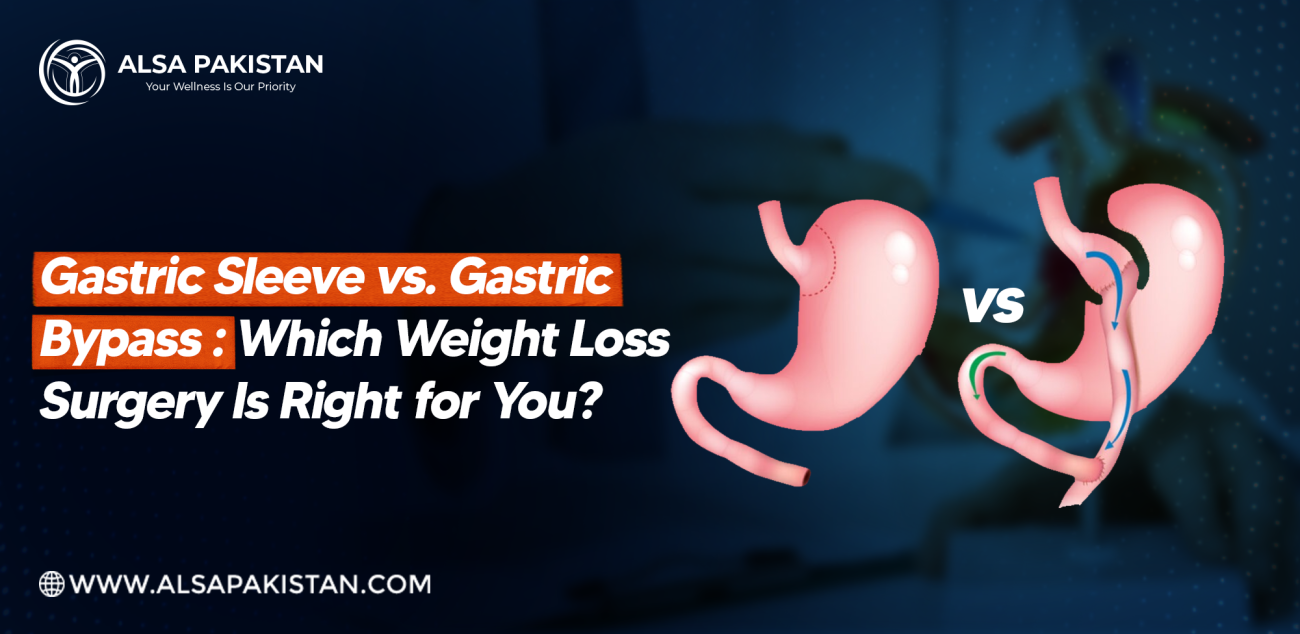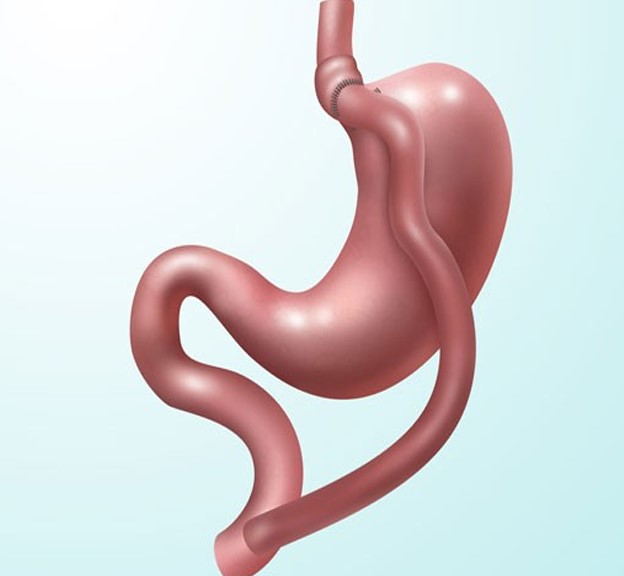Blogs

Gastric sleeve vs gastric bypass: Which weight loss surgery is right for you?
In today’s obesity treatment options, one of the more effective forms of treatment for serious obesity is bariatric surgery. It is fruitful in improving metabolic conditions associated with critical obesity. Moreover, it is available in various types. But the gastric sleeve and gastric bypass (Roux-Y gastric bypass) are probably the most common effective treatments for severe overweight conditions. Both procedures facilitate significant maintenance of weight loss. However, they have differences in the surgical approach, weight loss mechanism and post-operative consequences. The decision regarding which option to select is dependent on multiple factors. For instance, the individual's health status/interests/goals and what is going to best fit their lifestyle.
Well-experienced surgeons like Dr Tahir at ALSA Pakistan not only diagnose the right issue but also guide their patients about the suitability of treatments. It remains helpful for patients to be bonded and confident about their surgeon throughout the procedure and afterwards. This article will establish a professional and thorough comparison of the gastric sleeve vs the gastric bypass procedures, as well as the pros and cons of each. The focus will be on procedural details, advantages, disadvantages, patient recovery, and suitability for a variety of patients.

Understanding The Two Procedures
Indeed, both procedures have the same end goal, but some aspects vary. Comprehension of the differences between the two procedures can significantly help to pick the better option. Here is a detail
Gastric Sleeve (Sleeve Gastrectomy)
The technique involves the surgical removal of between 75% and 80% of the stomach, leaving a narrow-tubed stomach, or a "sleeve". This restricts the amount of food that a person eats. In addition, the secretion of ghrelin, a hormone that regulates hunger, becomes less. This procedure does not reroute the intestines. Thus, there are no changes to the chemical nature of digestion and nutrients.
Moreover, calories are absorbed normally. However, the smaller stomach capacity develops early satiety or fullness while significantly restricting calories in the patient’s diet.
Physiological approach:
Its primary purpose is limitation. It creates less space in the tummy and obstructs hunger hormones. Hence, patients experience fullness even after eating very little. In addition, hunger signals are naturally controlled.
Cost:
A rough estimate of all charges included ranges between PKR 450000 - 600000
Risks:
Both procedures are generally safe in the hands of an expert bariatric surgeon, but there are risks. Relevant to the gastric sleeve include
- Leaking or bleeding of the staple line
- Nutritional deficiency (less common than with bypass)
- Bearable nausea or vomiting
- Acid reflux or GERD
Expected weight loss:
The average weight loss within 12 to 18 months after surgery is about 50-60% of the overall body weight.
Increase Your Health Expectancy with Bariatric Surgery At ALSA Pakistan
Gastric Bypass (Roux-Y gastric bypass)
In a more complicated type of gastric bypass, the surgeon decreases the volume of the stomach and reroutes the small intestine, too. In this procedure, an egg-sized pouch is formed at the top of the stomach that is then attached near the middle part of the small intestine (jejunum). This causes the majority of the stomach and a section of the small intestine (duodenum) to bypass with the aim of reducing food intake and absorbing nutrients. This restricts and malabsorbs food, so people lose weight more rapidly and importantly with the gastric bypass than with the gastric sleeve operation (vertical sleeve gastrectomy).
Physiological approach:
Both restriction and malabsorption are involved. As food bypasses some of the intestines, this lessens calorie absorption while still providing a volumetric limitation to food intake. As well, gastric bypass may substantially affect gut hormones, allowing for a benefit to metabolic health and insulin sensitivity.
Expected weight loss:
Patients are supposed to lose somewhat 60-80% of overall body weight.
Most importantly, the longer-term results rely upon the patient’s exercise, diet, and follow-up maintenance
Cost:
The collective charges generally range from PKR 60000 to 80000
Risks:
While discussing the risk elements of gastric bypass, the prominent ones are
- Internal hernia
- nausea, diarrhoea, and faintness when people eat sugary foods.
- Malabsorption
- Abdominal obstruction, perforation, and ulcers of the bowel
Gastric bypass needs more digestive tract rearrangement than the sleeve. It carries a bit more nutritional and surgical risk, but these are manageable when performed with a laparoscopic technique.
Health Benefits Beyond Weight Loss
Both surgical options not only facilitate pound loss but are also notably effective metabolic surgeries. Both surgeries have demonstrated astonishingly successful evidence for improvement or resolution of obesity-associated conditions:
Type 2 Diabetes:
Gastric bypass has a better chance of remission because of the hormonal nature of insulin sensitivity change. The gastric sleeve is also very effective.
Hypertension:
Improvement can occur with both procedures, because it is related to the reduction of calories and the strain it puts on the cardiovascular system.
Sleep Apnea:
As patients lose pounds in addition to relieving breathing during sleep, they improve their apnea.
Joints ache:
If weight decreases, then joints bear less stress. Hence, mobility rises greatly as weight falls away.
PCOS:
After surgery, the hormone balance, achieved through treatment to regulate the menstrual cycle. Regular physical activity is one component. A healthy diet is another. Follow-up appointments with a doctor are also components of long-term success in life.
Comparing gastric sleeve vs gastric bypass at a glance
| Aspect | Gastric Sleeve (Sleeve Gastrectomy) | Gastric Bypass (Roux-Y Gastric Bypass) |
|---|---|---|
| Surgical Technique | Removes 75–80% of the stomach, leaving a narrow sleeve. | Creates a small pouch (egg-sized) from the stomach and connects it to the middle of the small intestine. |
| Primary Purpose / Mechanism | Restriction — reduces stomach capacity and hunger hormone (ghrelin) secretion. | Restriction and malabsorption — reduces stomach size and bypasses part of the intestines. |
| Weight Loss | 50–60% of overall body weight | 60–80% of overall body weight. |
| Sustainability | Highly sustainable with lifestyle and dietary maintenance. | Equally sustainable with good follow-up and lifestyle adherence. |
| Estimated cost (Pakistan) | PKR 450,000 – 600,000 | PKR 600,000 – 800,000 |
| Risks & Complications | Staple line leak or bleeding, Nutritional deficiency Mild nausea/vomiting Acid reflux (GERD | Internal hernia or stricture Dumping syndrome Malabsorption of vitamins Bowel obstruction, or ulcer |
| Safety | Safe with an expert bariatric surgeon | Safe with modern laparoscopic techniques |
Conclusion
In the end, both sleeve gastrectomy and gastric bypass offer a transformative treatment of obesity and obesity-related disease. Sleeve gastrectomy is a procedure that is simple and effective, with fewer long-term nutritional deficiencies than other procedures. Gastric bypass leads to the greatest weight that people lose and the most metabolic aspects that improve, but it is highly complex and requires long-term follow-up.
The best procedure for an individual patient will ultimately be determined per the patient's medical needs and preferences and the surgeon's recommendation.
Dr Tahir Yunus at ALSA Pakistan is publicized for appropriate preoperative preparation and exceptionally precise conduction of the procedure. Moreover, he is good at convincing people to commit to lifestyle changes and support postoperatively. Given, both procedures improve health, self-image, and quality of life, importantly, letting patients control their health and future again.

